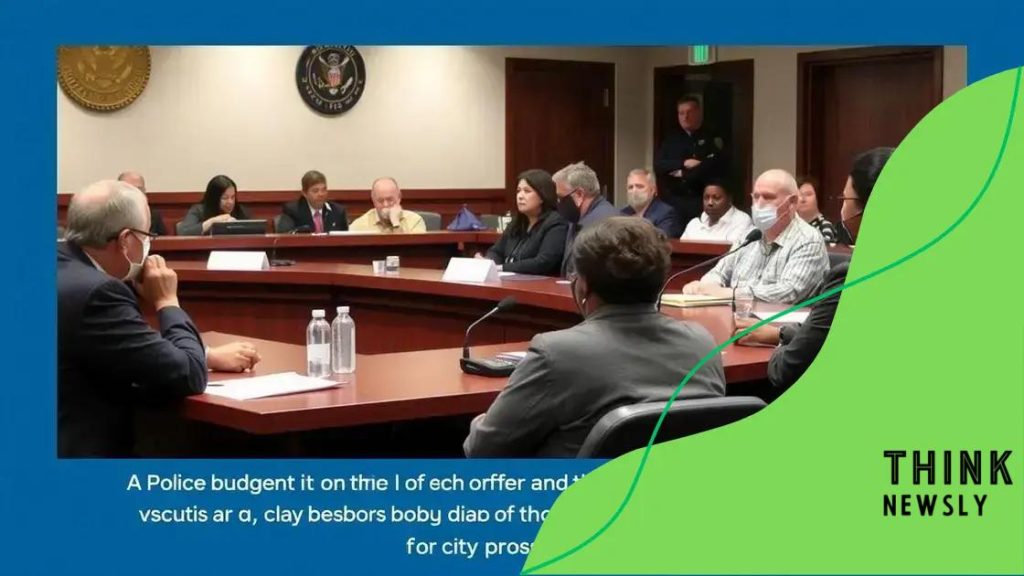Police budgets tied to votes: what you need to know

Anúncios
Police budgets tied to votes significantly influence community safety and law enforcement effectiveness, highlighting the importance of public participation in funding decisions that align with community needs and values.
Police budgets tied to votes shape the very fabric of our communities, influencing safety and accountability. Ever wondered how your vote impacts local law enforcement funding? This article explores the intricate ties between public opinion and police financial allocations.
Anúncios
Understanding the connection between police budgets and votes
Understanding the connection between police budgets and votes is crucial for grasping how community safety is financed. When citizens head to the polls, they make choices that directly influence how law enforcement agencies are funded. These decisions determine not only the size of budgets but also how resources are allocated, impacting services like community outreach and crime prevention.
Key Factors in Budget Decisions
Several factors play significant roles in shaping police budgets during elections. Voter priorities often reflect community needs. Important aspects include:
- Community engagement and transparency
- Crime rates in specific areas
- Public perception of safety
- Local government policy goals
As voters consider these factors, they begin to understand how their support—or opposition—affects policing in their neighborhoods. It’s not just about financial numbers; it’s about how budgets translate to real-world policing practices.
Anúncios
The Role of Public Opinion
Public opinion can sway budgetary allocations significantly. Crime statistics might suggest a need for more officers; however, community sentiment can direct funds toward social programs instead. Discussions around police funding often lead to deeper conversations about fairness and accountability in law enforcement. Voters want to know how effectively their tax dollars are being used.
Moreover, high-profile incidents can shift public perception overnight. Following such events, citizens may demand budgeting changes that emphasize community relationships over traditional policing styles. Understanding this cycle is vital for voters who wish to make informed decisions.
In conclusion, the intersection of police budgets and votes illustrates the evolving landscape of community safety. When informed, citizens can drive the discussion towards a more equitable allocation of resources, fostering a safer environment for everyone.
The impact of community votes on policing finances
The impact of community votes on policing finances is a critical issue for many local governments. When citizens go to the polls, they make decisions that directly shape how much funding police departments receive. These financial choices can determine the effectiveness and reach of law enforcement in communities.
How Votes Translate to Budgets
Understanding how community votes affect budgets is essential. Voters have the power to support or oppose funding initiatives that can expand or limit police resources. Key factors include:
- Ballot measures for police funding
- Local tax levies designated for law enforcement
- Community feedback during public hearings
- Civic involvement in local government decisions
When communities prioritize safety through their votes, they may approve measures that increase police budgets. However, in times of heightened awareness around social justice, voters may choose to redirect funds towards community programs instead.
The Role of Civic Engagement
Civic engagement plays a significant role in determining police finances. Active community participation can steer funding in several directions. Residents can advocate for:
- Increased accountability within police departments
- Investments in mental health resources
- Funding for community-based safety initiatives
- Police training on de-escalation techniques
These choices reflect community values and can lead to essential changes in how policing funds are utilized. When citizens voice their needs, local governments often feel obliged to listen.
Ultimately, the connection between votes and policing budgets underscores the importance of public participation in local governance. A well-informed electorate can influence how effectively police departments operate, ensuring they meet the needs of the community while maintaining public trust.
How budget decisions affect law enforcement effectiveness

Budget decisions have a profound effect on law enforcement effectiveness. The allocation of funds can determine how well police departments can operate and serve their communities. Limited budgets often mean fewer resources for training, equipment, and community outreach.
Impact on Training and Resources
When budgets are tight, training opportunities can be cut. Police officers may miss out on critical programs that teach important skills, such as:
- De-escalation techniques
- Crisis intervention
- Community policing strategies
- Use of technology in crime prevention
Lack of training can lead to poor interactions with the community, which affects trust and safety. More funds typically allow departments to invest in comprehensive training programs that keep officers informed and prepared.
Community Policing Initiatives
Another area affected by budget choices is community policing. Departments focused on engaging with the community often need substantial funding for:
- Outreach programs
- Public safety workshops
- Neighborhood patrols
- Youth engagement activities
These initiatives not only improve relationships between police and residents but also promote community safety. However, without adequate financing, such opportunities may be compromised, leading to strained relations and heightened tensions.
Additionally, the equipment used by law enforcement greatly impacts their effectiveness. Proper funding can ensure that police have access to the latest technology for monitoring crime and conducting investigations. Meanwhile, outdated or inadequate resources can hinder efficient law enforcement operations.
In summary, budget decisions play a critical role in shaping how effectively police departments can operate. By ensuring adequate funding, communities can enhance public safety and facilitate positive interactions between law enforcement and citizens.
Case studies: cities changing their police budgets
Examining case studies of cities that have changed their police budgets reveals important trends and insights. Many communities have taken a critical look at their funding priorities. These changes reflect shifting societal values and demands for accountability in law enforcement.
City A: Increased Funding for Community Programs
In City A, residents voted to redirect a portion of the police budget towards community programs. This move aimed to enhance public safety without solely relying on law enforcement. Key outcomes included:
- Improved relationships between police and community members
- Reduction in crime rates due to proactive outreach
- Increased funding for mental health services
- More resources for youth engagement initiatives
The success of this initiative underscored the potential benefits of investing in community-based solutions.
City B: Calls for Defunding
In City B, following heightened awareness of police misconduct, a significant movement arose calling for defunding the police. In response, the city council faced pressure to reconsider their entire budget. The result was a reduction in police funding and reallocating resources towards:
- Social services and health programs
- Affordable housing projects
- Crisis response teams
- Community policing efforts focused on transparency
This transformation aimed to address systemic issues while still maintaining safety through community engagement.
The Lessons Learned
These case studies illustrate the dynamic relationship between budget decisions and community needs. They shed light on the importance of public involvement in shaping funding priorities. When citizens actively participate in discussions about policing and budgets, they can significantly influence the direction of law enforcement practices.
By analyzing these cities, it becomes clear that thoughtful revisions to police budgets can lead to positive changes in community relations and public safety outcomes. The experiences of City A and City B serve as valuable examples for other communities considering similar changes.
Future trends in police funding and community engagement
Future trends in police funding and community engagement are becoming increasingly significant as cities re-evaluate their approaches to public safety. With ongoing discussions around police reform, communities are exploring new and innovative ways to allocate resources.
The Shift to Community-Based Funding
One emerging trend is the shift towards community-based funding models. Cities are starting to recognize that investing in community resources can enhance safety without solely relying on law enforcement. Key areas of focus include:
- Funding social services that address root causes of crime
- Supporting mental health and addiction recovery programs
- Encouraging youth engagement initiatives
- Promoting economic development in underserved areas
These initiatives help create a safer environment by addressing issues before they escalate into crime.
Technology and Transparency
As technology evolves, police departments are increasingly incorporating digital tools to promote transparency and accountability. Some future trends include:
- Body cameras for enhanced officer accountability
- Data analytics to assess policing strategies
- Public dashboards showing department performance metrics
- Community apps for quick communication with residents
These advancements not only build trust but also foster a sense of partnership between law enforcement and the community.
Collaborative Policy Making
Another significant trend is the move towards collaborative policy making. Involving community members in budget decisions can lead to better outcomes. By prioritizing:
- Public forums for discussion
- Inclusive budgeting processes
- Surveys to gather community input
- Partnerships with local organizations
Communities can ensure that funding aligns with their needs and expectations. This collaborative approach can lead to more effective policing and increased community satisfaction.
Overall, the future of police funding will likely focus on innovative, community-centered approaches that promote safety and well-being, reflecting the needs and values of the community.
FAQ – Frequently Asked Questions about Police Budgets and Community Engagement
How do police budgets impact community safety?
Police budgets directly affect how many resources are available for law enforcement, including training, equipment, and community programs, which in turn influence overall community safety.
What are some ways communities can influence police funding decisions?
Communities can influence police funding through voting on budget proposals, attending public forums, and advocating for specific allocations that address community needs.
Why is transparency important in police budgets?
Transparency helps build trust between law enforcement and the community, allowing residents to understand how funds are being used and ensuring accountability.
What trends are emerging in community engagement with police departments?
Emerging trends include increased collaboration on budget decisions, investment in community programs, and the use of technology to enhance communication and transparency.





